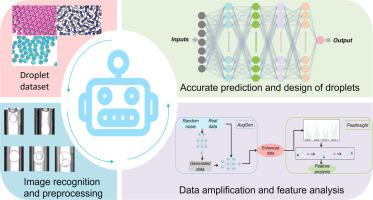Prediction of deep learning algorithms for the microemulsion generation conditions in complex environments
IF 6.3
3区 工程技术
Q1 ENGINEERING, CHEMICAL
Journal of the Taiwan Institute of Chemical Engineers
Pub Date : 2025-09-20
DOI:10.1016/j.jtice.2025.106414
引用次数: 0
Abstract
Background
Constructing high-quality datasets for AI-driven microemulsion prediction remains challenging due to limitations in chip design, imaging hardware, and fluid dynamics. Conventional semi-empirical models suffer from poor accuracy and generalizability in complex nonlinear systems, while traditional microfluidic chips often yield non-spherical droplets. Optical constraints in capillary-based systems further hinder data acquisition.
Methods
A deep learning framework integrates three components: (1) A multi-branch CNN with residual modules and self-attention (RAM-CNN) for robust droplet/fluid morphology recognition; (2) GAN-LGBMnet, combining adversarial networks and LightGBM, to augment small datasets and analyze key features; (3) A multi-output neural network (MO-DNN) predicting single/double-emulsion parameters. The system is deployed via an intuitive GUI (MICA) for non-specialist use.
Significant Findings
RAM-CNN achieves 100 % fluid-regime and 95.8 % droplet-morphology recognition accuracy, maintaining >91 % performance under ±28 % brightness variations. Enhanced by GAN-LGBMnet, MO-DNN predicts droplet diameters and generation rates with MAPE <7 % for both emulsion types. The MICA platform demonstrates <10 % error on unseen data, enabling precise emulsion design. This work bridges theoretical models with practical microfluidic optimization through automated, user-friendly AI tools.

复杂环境下微乳液生成条件的深度学习算法预测
由于芯片设计、成像硬件和流体动力学的限制,为人工智能驱动的微乳液预测构建高质量的数据集仍然具有挑战性。传统的半经验模型在复杂非线性系统中存在精度差和泛化性差的问题,而传统的微流控芯片往往产生非球形液滴。基于毛细血管系统的光学限制进一步阻碍了数据采集。方法深度学习框架由三个部分组成:(1)基于残差模块和自关注的多分支CNN (RAM-CNN),实现对液滴/流体形态的鲁棒识别;(2) GAN-LGBMnet,结合对抗网络和LightGBM,增强小数据集并分析关键特征;(3)多输出神经网络(MO-DNN)预测单/双乳液参数。该系统通过一个直观的GUI (MICA)部署,供非专业人员使用。ram - cnn实现了100%的流体状态和95.8%的液滴形态识别准确率,在±28%的亮度变化下保持了91%的性能。在GAN-LGBMnet的增强下,MO-DNN预测两种乳液类型的液滴直径和生成速率的MAPE均为7%。MICA平台在未见数据上显示出10%的误差,从而实现了精确的乳液设计。这项工作通过自动化、用户友好的人工智能工具将理论模型与实际微流控优化联系起来。
本文章由计算机程序翻译,如有差异,请以英文原文为准。
求助全文
约1分钟内获得全文
求助全文
来源期刊
CiteScore
9.10
自引率
14.00%
发文量
362
审稿时长
35 days
期刊介绍:
Journal of the Taiwan Institute of Chemical Engineers (formerly known as Journal of the Chinese Institute of Chemical Engineers) publishes original works, from fundamental principles to practical applications, in the broad field of chemical engineering with special focus on three aspects: Chemical and Biomolecular Science and Technology, Energy and Environmental Science and Technology, and Materials Science and Technology. Authors should choose for their manuscript an appropriate aspect section and a few related classifications when submitting to the journal online.

 求助内容:
求助内容: 应助结果提醒方式:
应助结果提醒方式:


